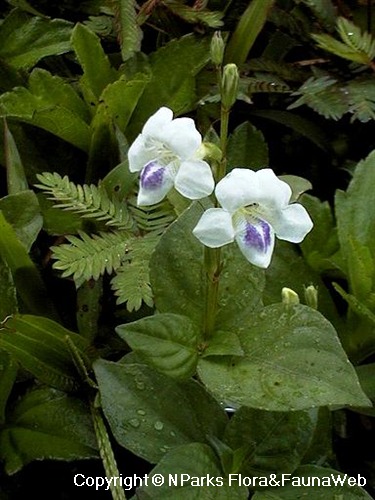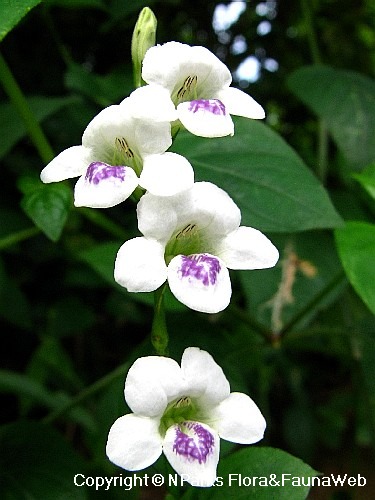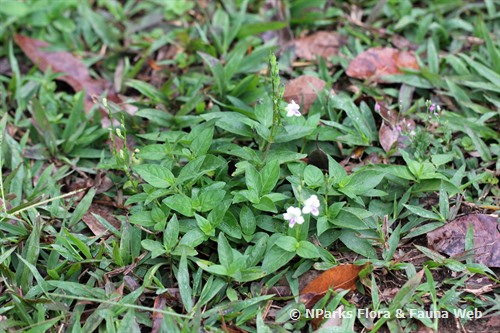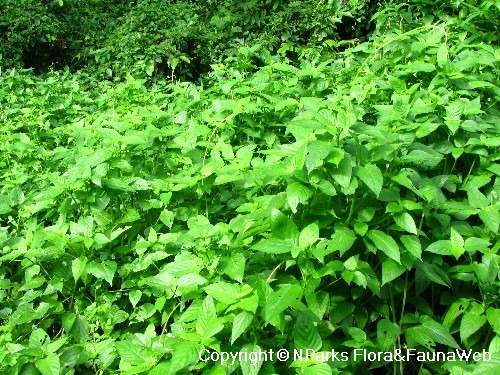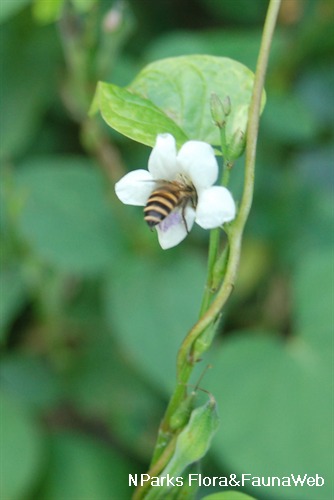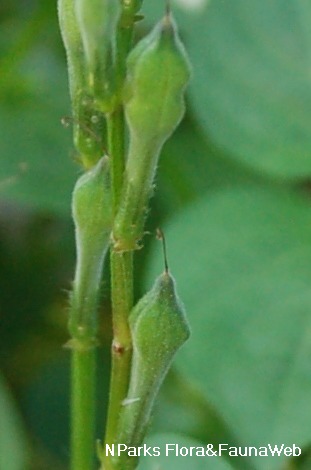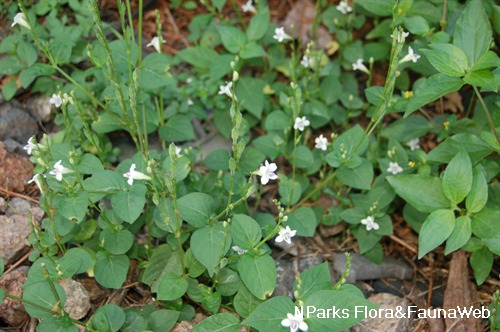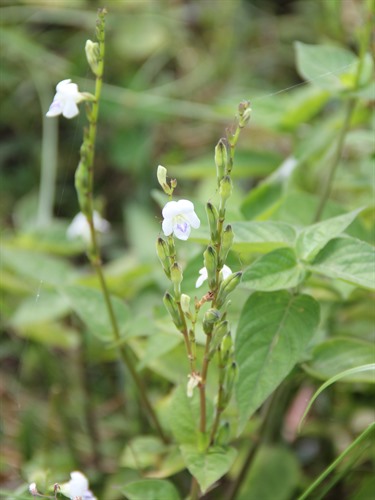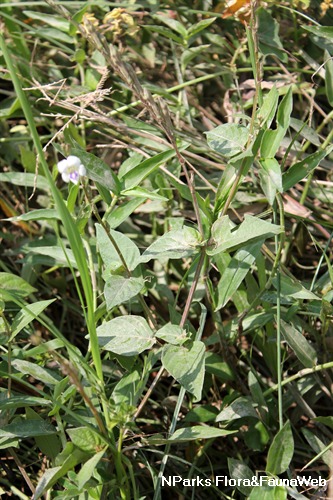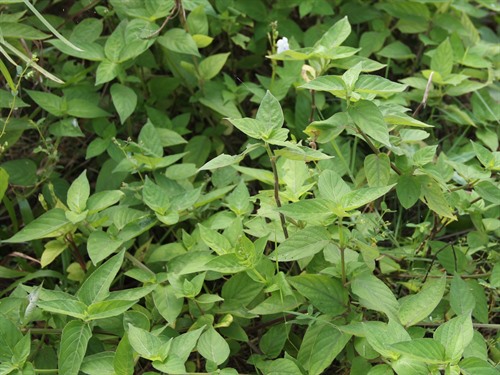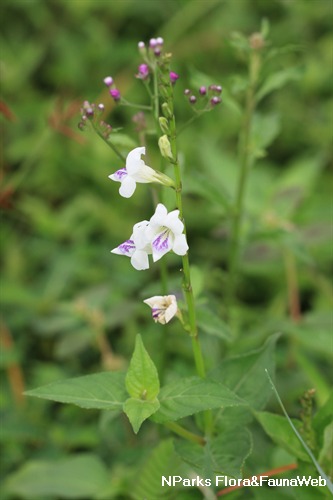
Back
Asystasia gangetica (Nees) Ensermu subsp. micrantha
| Family Name: | Acanthaceae |
| Synonyms: | Asystasia coromandeliana, Asystasia intrusa, Justicia gangetica |
| Common Name: | Common Asystasia, Chinese Violet, Creeping Foxglove, Ganges Primrose, 十万错花 |
Name
Classifications and Characteristics
| Plant Division | Angiosperms (Flowering Seed Plants) |
|---|---|
| Plant Growth Form | Shrub |
| Mode of Nutrition | Autotrophic |
| Maximum Height | 0.5 m |
Biogeography
| Native Distribution | India, Peninsular Malaysia and Africa |
|---|---|
| Native Habitat | Terrestrial |
| Local Conservation Status | Non-native (Spontaneous (Naturalised)) |
Description and Ethnobotany
| Growth Form | A herbaceous creeping groundcover, commonly found growing as a weed rather than a garden plant. It has a sprawling or weakly climbing habit, and tends to grow into dense mats that smother neighbouring vegetation. |
|---|---|
| Foliage | Leaves are green, sparsely hairy, opposite, smooth-edged, and egg-shaped to broadly lanceolate in shape (8 cm long, 4 cm wide). |
| Flowers | The flowers are in small, one-sided racemes at the stem tips, with the flowers at the bottom of the raceme opening first. The individual flowers are tubular, white, up to 1 inch (2.5 cm) long, and have 5 rounded lobes, purple, vein-ridged markings on the lower lip, and 4 stamens. This species is free-flowering. |
| Fruit | Explosively dehiscent fruits known as capsules are initially green, but becomes brown and dry after dehiscence (3.6 cm long). The fruit resembles an upside down cello and contains 4 whitish to brownish black, circular seeds which are flattened and beaked (5 mm long, 1 mm thick). Fruits contain 3 mm-long hooks which help to propel the seeds further away from the plant during explosive dehiscence. |
| Habitat | In Australia, this species is considered invasive and a serious threat to native ecosystems. |
| Associated Fauna | Host plant for the Great Eggfly (Hypolimnas bolina bolina), Autumn Leaf (Doleschallia bisaltide), Blue Pansy (Hypolimnas orithya wallacei) and Jacintha Eggfly (Hyoplimnas bolina jacintha). |
| Cultivation | This fast-growing species grows best under semi-shade or full shade, but plants grown in full sun require sufficient moisture. It is tolerant of many soil types, but optimal growth occurs in well-drained, but moist soils that are rich in compost. Individuals should be spaced 0.45 - 0.6 m apart. This species can grow aggressively and should be restrained with pruning. Propagate by seed, stem cuttings or layering. |
| Etymology | The genus "Asystasia" means inconsistency, referring to radially symmetrical flowers in this genus which is uncommon in the family Acanthaceae. The species epithet "gangetica" was named after the Ganges River in India. This species was likely observed near the Ganges River. |
| Ethnobotanical Uses | Edible Plant Parts : Edible Leaves |
Landscaping Features
| Desirable Plant Features | Ornamental Flowers |
|---|
Fauna, Pollination and Dispersal
| Fauna Pollination Dispersal Associated Fauna | Bee-Attracting, Butterfly Host Plant (Leaves, Associated with: Hypolimnas bolina jacintha, Doleschallia bisaltide, Junonia orithya ssp wallacei), Butterfly-Attracting |
|---|
Plant Care and Propagation
| Light Preference | Semi-Shade, Full Sun |
|---|---|
| Water Preference | Moderate Water |
| Plant Growth Rate | Fast |
| Rootzone Tolerance | Drought Tolerant |
Foliar
| Mature Foliage Colour(s) | Green |
|---|---|
| Leaf Area Index (LAI) for Green Plot Ratio | 4.5 (Shrub & Groundcover - Dicot) |
Floral (Angiosperm)
| Flower Colour(s) | White, Purple |
|---|
Image Repository
Others
| Master ID | 409 |
|---|---|
| Species ID | 1705 |
| Flora Disclaimer | The information in this website has been compiled from reliable sources, such as reference works on medicinal plants. It is not a substitute for medical advice or treatment and NParks does not purport to provide any medical advice. Readers should always consult his/her physician before using or consuming a plant for medicinal purposes. |

